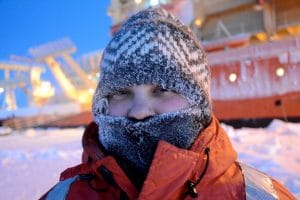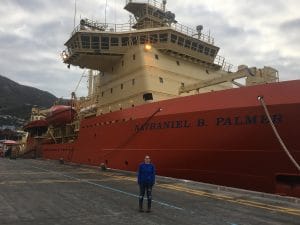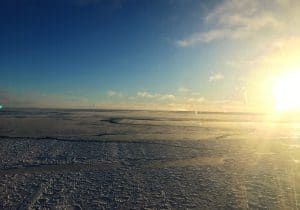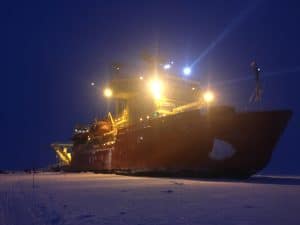 A 2016 graduate of Southern Arkansas University recently returned from a 65-day expedition to the Ross Sea in one of the harshest and most remote locations of the world – Antarctica.
A 2016 graduate of Southern Arkansas University recently returned from a 65-day expedition to the Ross Sea in one of the harshest and most remote locations of the world – Antarctica.
Casey O’Hara, who graduated from SAU with a BS in chemistry, was among the two dozen scientists who set sail from Lyttleton, New Zealand, for Antarctica on April 10. O’Hara, of Little Rock, Ark., said the expedition aimed to discover why, at a time when most polar areas are shrinking, the Ross Sea is covered with more ice than at any time in the past 30 years.
For more than two months, her home was the RVIB Nathaniel B. Palmer, a 308-foot-long U.S. icebreaker capable of cracking through three feet of level ice. O’Hara, a graduate student studying oceanography at Old Dominion University in Norfolk, Va., was part of the PIPERS (Polynyas, Ice Production and Seasonal Evolution in the Ross Sea) expedition, comprised of multiple research groups with scientists from eight countries. The group encountered harsh wintertime conditions at the bottom of the world: round-the-clock darkness, lacerating winds and heavy sea ice.
“It’s an experience I never thought I’d have, but I appreciate what I learned,” she said.
O’Hara talked about her educational experience at SAU. “As strange as it might sound, SAU actually found me,” she said. “The first time I ever heard about SAU was when I received a letter saying I had qualified for a scholarship. I Googled the school, went down to visit a day or two later, and applied that day!”
“The highlight of my career at SAU was definitely working with the Natural Resource Research Center. I learned new chemistry techniques, got to work with more instrumentation than I ever thought possible, made friends, and learned about myself.”
She said that what drew her to the University “was that it had a variety of academic opportunities, offered a great scholarship, and was close to home. Although not what I originally thought I would go into, I graduated with my bachelor’s in chemistry with an emphasis in analytical/instrumental analysis.”
She credited Dr. Gija Geme in particular for her mentorship. “She inspired me to get into chemistry, do research, and become a better scientist,” O’Hara said. “The highlight of my career at SAU was definitely working with the Natural Resource Research Center. I learned new chemistry techniques, got to work with more instrumentation than I ever thought possible, made friends, and learned about myself.”
“Looking at graduate schools, I wanted to continue exploring the analytical techniques I had acquired at the NRRC,” O’Hara said. “When I found ODU’s Department of Ocean, Earth and Atmospheric Science’s program, I learned that a graduate position with Dr. Peter Sedwick meant a two-month expedition to Antarctica to conduct research. I decided to jump on this unique opportunity and shift to oceanography.”
According to Science magazine, the expedition represented the “first winter research voyage into the Ross in nearly 20 years. The lure is the prospect of a better understanding of how the Sea’s harsh winters give birth to its floating ice, which has expanded even as ice packs in the Arctic and some other parts of Antarctica have shrunk.”

The NBP served as “home, lab space, gym, cafeteria, and lounge on our trip,” she said. “We only got off the ship when there were ice stations for conducting research on ice thick enough to walk around on.”
One blog entry on the trip described conditions as similar to being at “ground zero of a hurricane-strength wind event. It is quite incredible to experience such an epic demonstration of polar ocean-atmospheric interaction. … Energy is pouring out of the ocean like some sort of apocalyptic rapture as the cold, dry atmosphere rips out its tribute.”

Collecting seawater samples was vital to the research because “iron is an essential element in the summer months in the Southern Ocean surrounding Antarctica,” O’Hara said. “Phytoplankton utilizes this iron … to photosynthesize, which helps regulate carbon dioxide in the atmosphere,” she said. “There is not a well-established understanding of iron sources in the Southern Ocean, which is why this research is important.”
O’Hara said she is currently working on her coursework and beginning her thesis at ODU.

